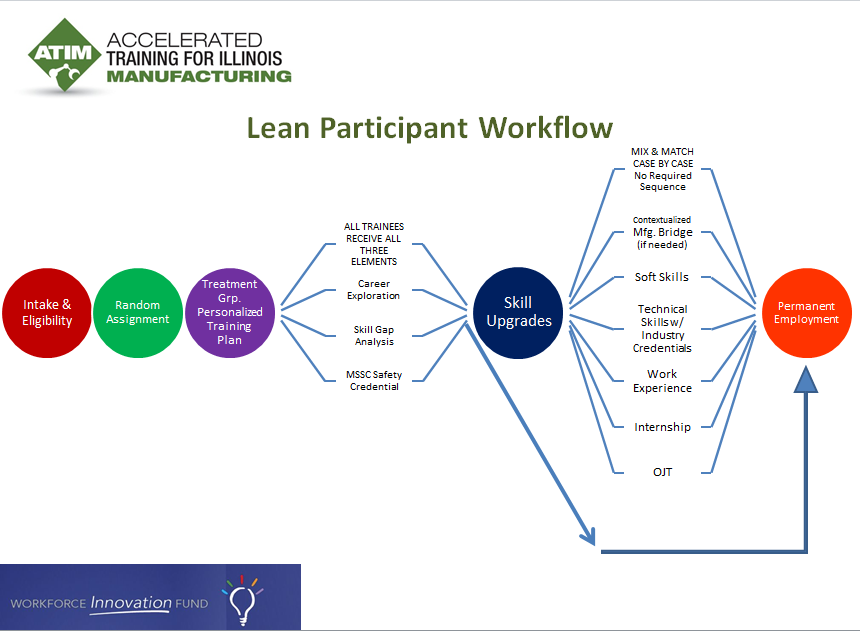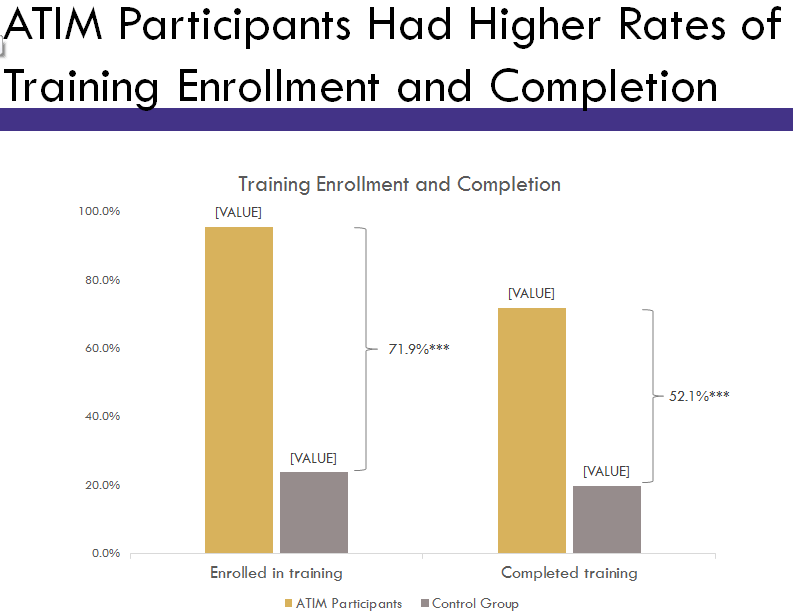
ATIM promoted the innovation of leveraging existing skills and working with trainers and businesses to create training options tailored for each person’s skill gap for the occupation or group of occupations they had targeted. Everyone in the Treatment Group received:
- enhanced career exploration,
- a personal skill gap analysis,
- a personal training plan and
- enrollment into training for a stackable industry recognized credential, the Manufacturing Skills Standards Council Safety (MSSC) certificate training. (Anyone already possessing this credential was allowed to bypass the MSSC training.)
From that point, next steps were unique to each individual and were determined by their personal short-term and long-term goals and their regional opportunities to enter manufacturing employment. Services could include any mix of: training for MSSC Certified Production Technician, American Welding Society or National Institute of Metalworking Skills certificates; essential work skills training; paid work experience, paid internships, and/or OJT. Participants with an urgent need for income were allowed to change their short-term plan upon discovering immediate employment opportunities; while others who had the resources to remain in training were allowed to modify their plan to continue with more advanced training so as to enter the workforce in a higher skill, higher pay occupation.
|
Enrollment: Treatment Group
|
Entered Training (90% of Enrolled)
|
Completed Training (85% of Entered Training)
|
Earn at Least 1 Industry Cert. (80% of Entered Training)
|
Number of Industry Credentials Earned
|
Enter Employment (85% of Completed Training)
|
| Target |
600 |
540 |
459 |
432 |
432 |
390 |
| Actual |
609 |
565 or 93%
|
461 or 82%
|
454 or 80%
|
1,267 |
427 or 94%
|
The Actual number may exceed Target number but not percent because actual enrollment exceeded the target.
This outcomes table includes 104 veterans automatically assigned to the treatment group due to statutory veterans’ priority of service requirements instead of being randomly assigned. These veterans counted toward meeting enrollment and outcomes goals, but were excluded from the impact evaluation.
|
 ATIM participants in the treatment group experienced higher rates of training enrollment, training completion, credential attainment, number of credential earned and employment following random assignment than members of the control group.
ATIM participants in the treatment group experienced higher rates of training enrollment, training completion, credential attainment, number of credential earned and employment following random assignment than members of the control group. Positive statistically significant differences in employment rates were documented during the second year after random assignment.
ATIM participants experienced higher earnings following random assignment than members of the control group. Statistically significant differences in earnings were documented during the second year following random assignment, with ATIM participants earning an average of approximately $5,000 more during that year than control group members.
- ATIM percent of participants entering training were 72 points above the control group
- ATIM percent of participant successful completion rates were 52 points above the control group
- ATIM percent of participant credential attainment rates were 55 points above the control group
- On average, individual ATIM participants earned 2 industry credentials more than the control group
- ATIM participants, on average, were employed for more than one-third of a quarter longer than the control group members during the second year following random assignment
- Supported the development of online, cross-program participant tracking and outcomes reporting, allowing case managers in different programs to see the progress of co-enrolled participants.
- The new practice of local workforce case managers utilizing Wagner-Peyser resources to conduct targeted recruitment of Unemployment Insurance recipients, with different messages tailored for specific audiences. This best practice was highly effective and has been incorporated into local WIOA implementation strategies in Illinois.
- Highlighted the vital importance of long-term public/private partnerships necessary to support work-based learning.
- Highlighted the positive impact of strong, well-informed case management and the use of an individually designed action plan (vs. a one-size-fits-all approach) on participant outcomes.
- Demonstrated the feasibility of early-exit based on proof-of-mastery of subject matter.
- Demonstrated the feasibility of accelerated training by community colleges.
- Provided valuable experience in how to incorporate business partners into program implementation.
- Demonstrated having a private sector expert on the team improves business engagement. The projects also demonstrated the quality of this person interacting with partners and potential partners has a direct impact on results.
- Demonstrated the value of establishing direct, two-way communication between State partners and front-line staff to improve understanding of project goals and implementation issues.
ATIM implementation was not without challenges. However, the State and regional partners were committed to successful implementation and improved outcomes for manufacturers and workers. The efforts of these teams were recognized nationally; with partners from Commerce and SIU invited by USDOL to share best practices with other WIF grantees at multiple national technical assistance events, webinars and National Convenings.
